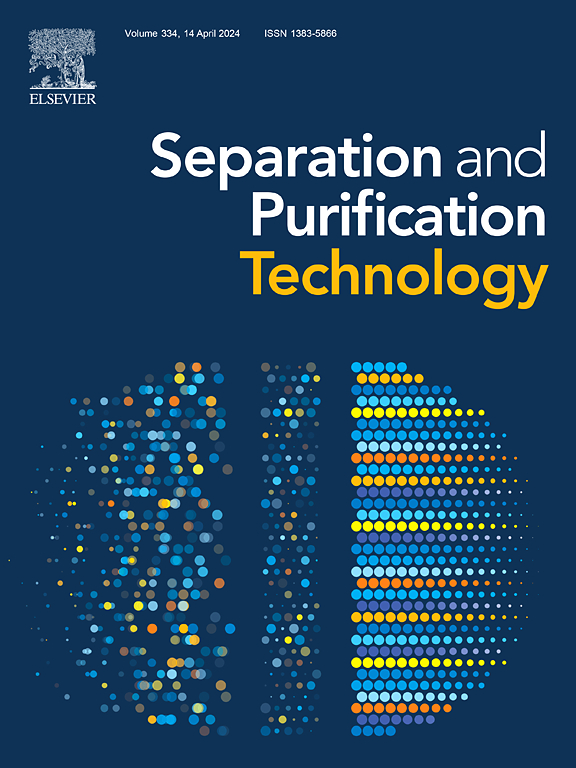The role of Mn2O3-Cu NanoPCM in aluminum cans for enhancing thermal performance and freshwater yield of M-shaped basin solar desalination system: An experimental analysis
IF 8.1
1区 工程技术
Q1 ENGINEERING, CHEMICAL
引用次数: 0
Abstract
This research investigates enhancements to the freshwater output of solar desalination systems by integrating Mn2O3-doped Cu nanocomposite (MC) and Paraffin RT31-phase change materials (P) into an M−shaped absorber plate single-slope solar desalination system (SMD) for improved thermal storage. Five configurations were evaluated: a conventional solar still (CSS), and SMDs with individual PC, PM, and MCP integrations, as well as one without MCP. The impact of these modifications on SMD productivity was quantified by coupling them with aluminum cans. The experimental setup included: (stage 1) CSS (without MCP), (stage 2) SMD, (stage 3) SMD with PC, (stage 4) SMD with PM, and (stage 5) SMD with MCP and aluminum cans. Performance was measured and compared in Vijayawada (KLEF), India (80°63′E, 16°51′N). Results indicated that while MCP affected daytime (summer and winter) freshwater yield, the overall output improved in the SMD using MCP. Total daily accumulated freshwater yields for stages 2–5 were 12.5 %, 16.5 %, 20.5 %, and 25.4 % higher than stage 1, respectively. Winter productivity increased across all MCP-integrated configurations, from 3.45 kg per meter2 (stage 1) to 6.32 kg per meter2 (stage 5). Summer productivity followed a similar trend, increasing from 2.953 kg/m2 (stage 1) to 6.594 kg/m2 (stage 5). Overall thermal efficiencies ranged from 32.9 % (CSS) to 42.7 % (MCP), with stage 5 exhibiting the highest productivity and efficiency. The use of aluminum cans promote recycling and offers a cost-effective material option for the M−shaped basin solar desalination system.


铝罐中Mn2O3-Cu纳米cm对m型盆地太阳能脱盐系统热性能和淡水产量的提高作用:实验分析
本研究通过将mn2o3掺杂Cu纳米复合材料(MC)和石蜡rt31相变材料(P)集成到M -型吸收板单坡太阳能海水淡化系统(SMD)中,以提高储热能力,从而提高太阳能海水淡化系统的淡水产量。评估了五种配置:传统的太阳能蒸馏器(CSS),集成了PC、PM和MCP的smd,以及没有MCP的smd。通过将这些改性与铝罐耦合,量化了这些改性对SMD生产率的影响。实验设置包括:(第1阶段)CSS(不含MCP),(第2阶段)SMD,(第3阶段)SMD与PC,(第4阶段)SMD与PM,(第5阶段)SMD与MCP和铝罐。在印度的Vijayawada (KLEF)(80°63'E, 16°51'N)进行了性能测量和比较。结果表明,MCP虽然会影响白天(夏季和冬季)的淡水产量,但在SMD中,MCP的总体产量有所提高。第2 ~ 5阶段的日累计淡水产量分别比第1阶段高12.5 %、16.5 %、20.5 %和25.4 %。在所有集成mcp的配置中,冬季生产率都有所提高,从3.45 kg / m2(阶段1)提高到6.32 kg / m2(阶段5)。夏季产量也有类似的变化趋势,从第1阶段的2.953 kg/m2增加到第5阶段的6.594 kg/m2。总体热效率范围从32.9 % (CSS)到42.7 % (MCP),其中阶段5的生产力和效率最高。铝罐的使用促进了回收利用,并为M形盆地太阳能海水淡化系统提供了一种具有成本效益的材料选择。
本文章由计算机程序翻译,如有差异,请以英文原文为准。
求助全文
约1分钟内获得全文
求助全文
来源期刊

Separation and Purification Technology
工程技术-工程:化工
CiteScore
14.00
自引率
12.80%
发文量
2347
审稿时长
43 days
期刊介绍:
Separation and Purification Technology is a premier journal committed to sharing innovative methods for separation and purification in chemical and environmental engineering, encompassing both homogeneous solutions and heterogeneous mixtures. Our scope includes the separation and/or purification of liquids, vapors, and gases, as well as carbon capture and separation techniques. However, it's important to note that methods solely intended for analytical purposes are not within the scope of the journal. Additionally, disciplines such as soil science, polymer science, and metallurgy fall outside the purview of Separation and Purification Technology. Join us in advancing the field of separation and purification methods for sustainable solutions in chemical and environmental engineering.
 求助内容:
求助内容: 应助结果提醒方式:
应助结果提醒方式:


